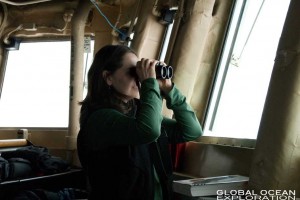
A Glaucous Gull, one of the more common species in the Bering Sea, follows the ship as we steam to the next station.
In my opinion, the luckiest researchers on the ship are the ornithologists, Kathy Kuletz and Liz Labunski from the US Fish and Wildlife Service, who stay on the bridge from sunrise to sunset conducting bird surveys. They don’t miss a bird, seal, walrus or beautiful vista as they identify and log all of the birds and mammals we encounter along the ship track. The objective of their research is to contribute to the North Pacific Pelagic Seabird Database which has data starting in the 1950s! By cataloguing what is in the Bering Sea at various times of year and under various ice conditions, they add valuable data to this tremendous resource for all researchers to use. They have more than twenty cruises planned for this year and more in future years! In addition to adding to the database, Kathy and Liz, as part of their BSIERP (Bering Sea Integrated Ecosystem Program) study, will correlate bird densities with the oceanographic and fisheries data collected on this cruise and the others they will sail on.Â
Liz has been aboard the USCGC Healy since the beginning of March and has observed that there has been low diversity of the bird species; perhaps because of the heavy ice the Bering Sea is experiencing this year. The dominant species have been the Common Mure, Glaucous Gull, and Black-Legged Kittiwake. In addition to these species, they have observed Black Guillemots, Slaty Backed Gulls, Ivory Gulls and a variety of other species. It never ceases to amaze me that no matter how far from shore I can be and in seemingly freezing icy condition, the ship always encounters birds. Kathy and Liz use a specialized computer program which correlates the exact GPS location with their observations so that their distribution data is very accurate.  With this data and the oceanographic data collected on the cruise, they hope to gain an understanding of how large scale changes to the Bering Sea ecosystem may affect the populations and distribution of sea birds.Â
 
Liz Labunski, always with binoculars in hand, spots a pair of ivory gulls flying around the ship. These birds are not commonly found in our survey area but farther north. They blend in perfectly with the sea ice making them hard to follow. Â

A small flock of Black-Legged Kittiwakes rests on a small chunk of ice along the ice edge.
Â
